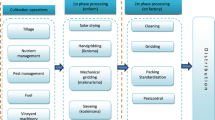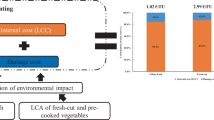Abstract
Purpose
Using apple consumption in Belgium as a case study, this study examines the environmental impacts associated with Belgian (BE) and New Zealand (NZ) apples, how impacts evolve throughout the year and how packaging affects this impact. Additionally, impacts associated with food losses and food waste along the chain are assessed. The study aims to delineate the most important factors in determining environmental impacts associated with apple.
Methods
The environmental impacts are calculated using the ILCD (International Reference Life Cycle Data System) approach. The functional unit is 1 kg of apples purchased by a consumer in the supermarket. Primary data was collected through players along the chain. Various scenarios are analysed for both the BE and NZ apples, based on the moment of purchase and packaging method. Food loss and waste impacts are assessed by splitting the impacts along the chain into three categories: apples lost along the supply chain, apples purchased and eaten by the consumer and apples purchased and wasted by the consumer.
Results and discussion
For all impact categories assessed, NZ apples come at a higher environmental cost than BE ones due to overseas transport. For both BE and NZ apples, minimum impacts are found for bulk apples at the beginning of the season, whereas maximum values are found for pre-packed apples at the end of the season. For BE apples, the choice of packaging method highly affects the impact, while it is negligible relative to shipping impacts for NZ apples. Altering secondary packaging materials of BE apples allows for impact reductions up to 50%. In the case of climate change, food waste and losses contribute up to 25% or 15% for BE or NZ apples, respectively, as all lost food travels in vain through the food chain and needs to be disposed of.
Conclusions
The study shows the importance of origin and packaging, whereas the moment of purchase hardly affects the environmental impact of apples. From a supply chain perspective, there is room for improvement as altering the use of secondary packaging greatly reduces impacts along the chain. The study further highlights how impacts are magnified by food waste and losses.









Similar content being viewed by others
Change history
10 December 2018
After publishing the abovementioned article in the “Online First Articles” list, an error was discovered.
References
Alexander P, Brown C, Arneth A, Finnigan J, Moran D, Rounsevell MDA (2017) Losses, inefficiencies and waste in the global food system. Agric Syst 153:190–200
Barthel L, Albrecht S, Baitz M et al (2007) The sustainability of packaging systems for fruit and vegetable transport in Europe based on life-cycle-analysis. Report on behalf of Stiftung Initiative Mehrweg, Germany
Berrens P (2016) “Duurzaamheid in de voedselketen: stay local or go global?” (Sustainability in the food chain: stay local or go global?). Master thesis, M.Sc. Bioscience Engineering. KU Leuven, Belgium
BFV (2017) Overview packaging materials. Belgische Fruitveiling (BFV)/Belgian Fruit Auction, St Truiden, Belgium. (http://www.bfv.be/uploadcms/documents/BFV_verpakking-overzicht_OK.pdf)
Blanke M, Burdick B (2005) Food (miles) for thought. Energy balance for locally grown vs imported apple fruit. Environ Sci Pollut Res 12:125–127
Blonk Agri-footprint (2015) Agri-footprint 2.0. Part 2: description of data. Blonk Agri-footprint, Gouda
Cerutti AK, Beccaro GL, Bruun S, Bosco S, Donno D, Notarnicola B, Bounous G (2014) Life cycle assessment application in the fruit sector: state of the art and recommendations for environmental declarations of fruit products. J Clean Prod 73:125–135
Cuellar AD, Webber ME (2010) Wasted food, wasted energy: the embedded energy in food waste in the United States. Environ Sci Technol 44:6464–6469
Davis J, Wallman M, Sund V et al (2011) Emissions of greenhouse gases from production of horticultural products—analysis of 17 products cultivated in Sweden. SR 828. Swedish Institute for Food and Biotechnology (SIK), Gothenburg
Defra (2010) Household food and drink waste linked to food and drink purchases. Foss House, Kings Pool, 1-2 Peasholme Green, York, UK
Eberle U, Fels J (2016) Environmental impacts of German food consumption and food losses. Int J Life Cycle Assess 21:759–772
ECOFYS, RDC, PRé (2017) Webinar on how to perform a hotspot analysis (in context of the EF pilot phase of the European Commission DG-ENV)
EPS (2017) EuroPoolSystem, blue rigid trays. http://www.europoolsystem.com/en/Trays/Blue-rigid-tray. Last accessed on 6 Oct 2017
European Commission (2013a) COM(2013)196. Communication from the Commission to the European Parliament and the Council. Building the single market for green products. European Commission, Brussels
European Commission (2016) Product environmental footprint guidance. Guidance for the development of product environmental footprint category rules (PEFCRs), version 6.0, November 2016. European Commission, Brussels
European Commission (2013b) Commission recommendation of 9 April 2013 on the use of common methods to measure and communicate the life cycle environmental performance of products and organisations (2013/179/EU). European Commission, Brussels
FAO (2013) Food wastage footprint. Impacts on natural resources. Summary report. FAO, Food and Agriculture Organisation, Rome
Godfray HCJ, Beddington JR, Crute IR, Haddad L, Lawrence D, Muir JF, Pretty J, Robinson S, Thomas SM, Toulmin C (2010) Food security: the challenge of feeding 9 billion people. Science 327:812–818
Goossens Y, Annaert B, De Tavernier J, Mathijs E, Keulemans W, Geeraerd A (2017a) Life cycle assessment (LCA) for apple orchard production systems including low and high productive years in conventional, integrated and organic farms. Agric Syst 153:81–93
Goossens Y, Berrens P, Charleer L, Coremans P, Houbrechts M, Vervaet C, de Tavernier J, Geeraerd A (2017b) Qualitative assessment of eco-labels on fresh produce in Flanders (Belgium) highlights a potential intention-performance gap for the supply chain. J Clean Prod 140:986–995
Gustavsson J, Cederberg C, Sonesson U et al (2011) Global food losses and food waste. Extent, causes and prevention. Swedish Institute for Food and Biotechnology (SIK), Gothenburg
Hanson C, Mitchell P (2017) The business case for reducing food loss and waste. Champions 123:1–24
Hepting DH, Jaffe J, Maciag T (2013) Operationalizing ethics in food choice decisions. J Agric Environ Ethics 27:453–469
Hic C, Pradhan P, Rybski D (2016) Food surplus and its climate burdens. Environ Sci Technol 50:4269–4277. https://doi.org/10.1021/acs.est.5b05088
Hospido A, Milà i Canals L, McLaren S, Truninger M, Edwards-Jones G, Clift R (2009) The role of seasonality in lettuce consumption: a case study of environmental and social aspects. Int J Life Cycle Assess 14:381–391
Huygens D, Lips D, Aerts S (2010) Short chain food supply in Flanders (Belgium): direct sales of farm made products. Bull Univ Agric Sci Vet Med Cluj-Napoca 67:154–160
Ilbery B, Maye D (2005) Food supply chains and sustainability: evidence from specialist food producers in the Scottish/English borders. Land Use Policy 22:331–344
Ingwersen WW (2012) Life cycle assessment of fresh pineapple from Costa Rica. J Clean Prod 35:152–163
Ingwersen WW, Stevenson MJ (2012) Can we compare the environmental performance of this product to that one? An update on the development of product category rules and future challenges toward alignment. J Clean Prod 24:102–108
IPCC (2006a) 2006 IPCC guidelines for national greenhouse gas inventories. Volume 4: agriculture, forestry and other land use. Chapter 11: N2O emissions from managed soils, and CO2 emissions from lime and urea application. Geneva, Switzerland
IPCC (2006b) 2006 IPCC guidelines for national greenhouse gas inventories. Volume 2: energy. Chapter 2: stationary combustion. Geneva, Switzerland
Johnson D, Hipps N, Hails S (2008) Helping consumers reduce fruit and vegetable waste: final report. WRAP UK. Available at http://www.wrap.org.uk/sites/files/wrap/WRAP%20RTL044-001%20Final%20report.pdf
Jones A (2002) An environmental assessment of food supply chains: a case study on dessert apples. Environ Manag 30:560–576
Keyes S, Tyedmers P, Beazley K (2015) Evaluating the environmental impacts of conventional and organic apple production in Nova Scotia, Canada, through life cycle assessment. J Clean Prod 104:40–51
Longo S, Mistretta M, Guarino F, Cellura M (2017) Life cycle assessment of organic and conventional apple supply chains in the north of Italy. J Clean Prod 140:654–663
Loureiro ML, Mccluskey JJ, Mittelhammer RC (2002) Will consumers pay a premium for eco-labeled apples? J Consum Aff 36:203–219
Mena C, Adenso-Diaz B, Yurt O (2011) The causes of food waste in the supplier-retailer interface: evidences from the UK and Spain. Resour Conserv Recycl 55:648–658
Milà i Canals L, Cowell SJ, Sim S, Basson L (2007) Comparing domestic versus imported apples: a focus on energy use. Environ Sci Pollut Res 14:338–344
Milà i Canals L, Muñoz I, Hospido A et al (2008) Life cycle assessment (LCA) of domestic vs imported vegetables. Case studies on broccoli, salad crops and green beans. CES working paper 01/08. Centre for Environmental Strategy, University of Surrey, Surrey
Mithraratne N, McLaren S, Barber A (2008) Carbon footprinting for the kiwifruit supply chain: methodology and scoping study. Report to Ministry of Agriculture and Forestry, New Zealand
Mundler P, Rumpus L (2012) The energy efficiency of local food systems: a comparison between different modes of distribution. Food Policy 37:609–615. https://doi.org/10.1016/j.foodpol.2012.07.006
Muñoz I, Canals LMI, Clift R (2008) Consider a spherical man: a simple model to include human excretion in life cycle assessment of food products. J Ind Ecol 12:521–538
Nemecek T, Kagi T (2007) Life cycle inventories of agricultural production systems, ecoinvent report no. 15. Agroscope Reckenholz-Tänikon Research Station ART, Zurich
Nemecek T, Schnetzer J (2011) Methods of assessment of direct field emissions for LCIs of agricultural production systems. Data v3.0 (2012). Agroscope Reckenholz-Tänikon Research Station ART, Zurich
Notarnicola B, Tassielli G, Renzulli PA, Castellani V, Sala S (2017) Environmental impacts of food consumption in Europe. J Clean Prod 140:753–765
Robertson K, Garnham M, Symes W (2014) Life cycle carbon footprint of the packaging and transport of New Zealand kiwifruit. Int J Life Cycle Assess 19:1693–1704
Röös E, Karlsson H (2013) Effect of eating seasonal on the carbon footprint of Swedish vegetable consumption. J Clean Prod 59:63–72
Saunders C, Barber A (2008) Carbon footprints, life cycle analysis, food miles: global trade trends and market issues. Polit Sci 60:73–88
Scholz K, Eriksson M, Strid I (2015) Carbon footprint of supermarket food waste. Resour Conserv Recycl 94:56–65. https://doi.org/10.1016/j.resconrec.2014.11.016
Sim S, Barry M, Clift R, Cowell SJ (2007) The relative importance of transport in determining an appropriate sustainability strategy for food sourcing. A case study of fresh produce supply chains. Int J Life Cycle Assess 12:422–431
Svanes E, Aronsson AKS (2013) Carbon footprint of a Cavendish banana supply chain. Int J Life Cycle Assess 18:1450–1463
Van Hauwermeiren A, Coene H, Engelen G, Mathijs E (2007) Energy lifecycle inputs in food systems: a comparison of local versus mainstream cases. J Environ Policy Plan 9:31–51
Vinyes E, Asin L, Alegre S, Muñoz P, Boschmonart J, Gasol CM (2017) Life cycle assessment of apple and peach production, distribution and consumption in Mediterranean fruit sector. J Clean Prod 149:313–320
WRAP (2008) The food we waste. Food waste report v2. Banbury, UK. Available at http://wrap.s3.amazonaws.com/the-food-we-waste.pdf
Acknowledgements
The authors greatly acknowledge the support of the Science, Engineering and Technology Group at KU Leuven for the Expertise Centre Ethics@Arenberg.
Author information
Authors and Affiliations
Corresponding author
Additional information
Responsible editor: Hans-Jürgen Garvens
Rights and permissions
About this article
Cite this article
Goossens, Y., Berrens, P., Custers, K. et al. How origin, packaging and seasonality determine the environmental impact of apples, magnified by food waste and losses. Int J Life Cycle Assess 24, 667–687 (2019). https://doi.org/10.1007/s11367-018-1522-0
Received:
Accepted:
Published:
Issue Date:
DOI: https://doi.org/10.1007/s11367-018-1522-0




